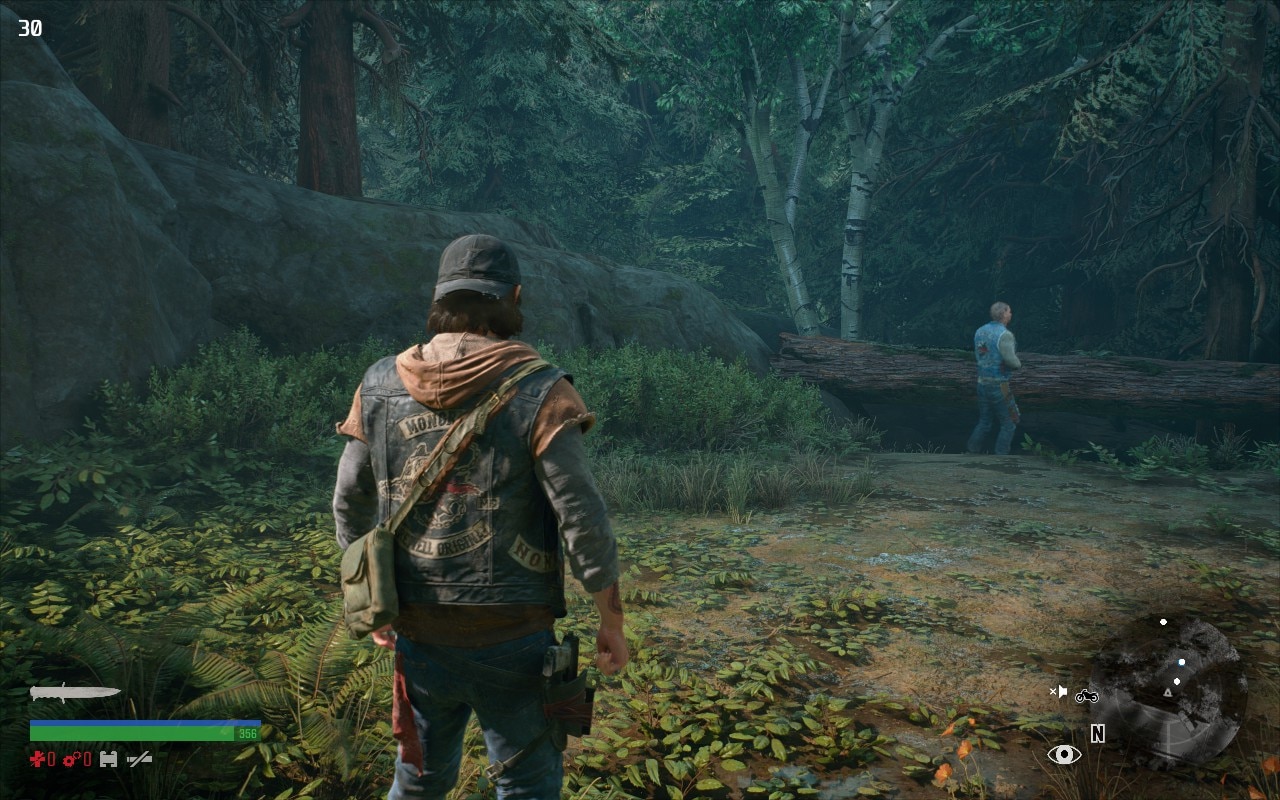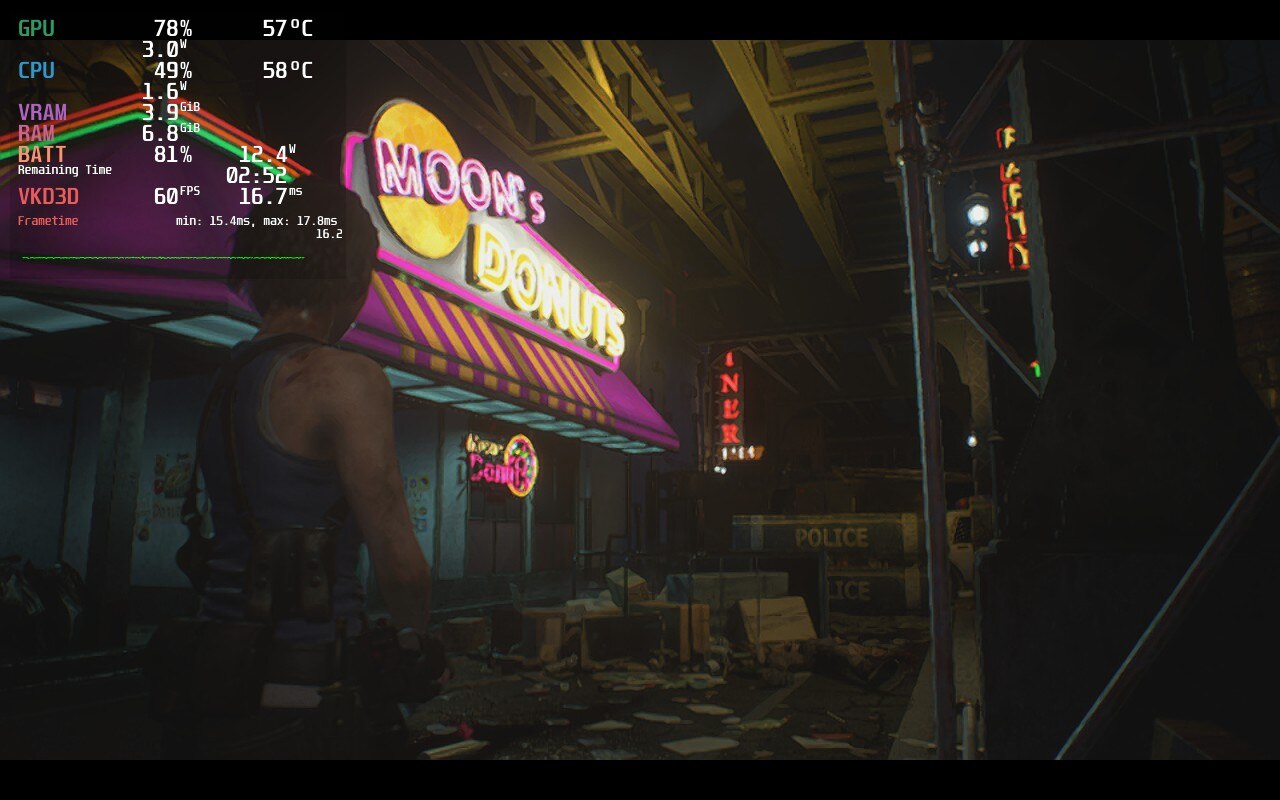Days Gone is a wild ride from the moment you set foot in its world. You will traverse a beautiful land, driving your motorcycle through the forests and war torn camps filled with other survivors, all from the perspective of a biker who falls into the ride or die stereotype with his crew coming before anything. In a devastated world with Zombies everywhere, you will have to watch out not just for the horde of mindless corpses, but you will also need to help obnoxious survivors…who are arguably worse and make themselves out to be way more important than they are. You will have to do quests for different camps and maintain the relationship with them all to use that favor to customize your bike and unlock a plethora of weapons you can use to fight off the horde. Thankfully, you won’t have to deal with hordes often as you ride your bike through the open world protecting your kin, but when you do, you better be ready for a fight that could cost your life if you aren’t prepared.
Default settings were able to run pretty well surprisingly, but sadly in the end it wasn't enough for a stable 40 FPS even just in the open world riding around on the bike. It is enough for stable 30 in most of the game but sadly, when hordes come into the equation, it could barely maintain 30 FPS unless you aren’t limiting TDP. The Temps were a lot higher than I would have expected on this game but for the default they were usually around high 80s low 90s for CPU and low to mid 80s for the GPU. Now when it comes to battery life you’d be lucky to hit 1.5hours but during the horde
Max settings sadly were not up to snuff even at max TDP. I was not able to get stable 30 no matter the situation I was in. The good thing is that the max settings only had 1 degree higher temps than the default did and had basically the same wattage. At this rate, I would not recommend trying to play the game at either of these settings. Though it is possible, you will not have a good experience throughout the game.

While temps can go down in certain areas, framerate instability and massive battery drain is much more common.
The recommended build keeps most of the quality close to max, while both looking and running better than it did on the PS4 version. When it comes to Proton, I ended up choosing the stable 7.0-3. Proton GE 7-27 did cool down CPU and GPU by around 1c-2c, but this was at the cost of framerate which I felt wasn’t a worthwhile tradeoff. Now the game has a very stable framerate, but it did have a few problem areas regarding helicopters flying over you or when you die from a huge horde of zombies with multiple fires around you. Could it have better temps and use less wattage? Yeah, but it still accomplishes what it sets out to do with a mix of high and medium quality settings. I went with lowering shadows and foliage distance first because less items would be on the screen and would help lower the CPU usage. This is necessary thanks to hordes maxing out the CPU with hundreds of zombies moving all at once independently. With the settings at this mix, I was able to set the TDP to 12. This left battery drain around 17W - 22W, while temps never went above 82c, which for a large open-world game with tons of moving models, really impressed me.
The 40FPS build took a lot to achieve. Sadly, I did have to sacrifice basically everything to low and lower the resolution quite a bit just to ensure the fps would stay stable, especially while experiencing a horde. This caused me to see how little a wattage difference these setting caused as well which made me see the pointlessness of a battery build for this game since it would be at 30fps with everything at low yet would only make the 30FPS build last about half an hour longer which does not seem worthwhile.


40 FPS might feel much smoother, the quality of the recommended build, as well as stability and better temps and battery drain, make the choice a no-brainer.
Throughout the entirety of my run, I had a great experience except for four crashes, which were seemingly at random. I hope this will be fixed, but it occurred regardless of the settings and Proton layer I was using, so I deduced this was an issue with the game internally. Otherwise, I didn’t encounter many issues while playing the game.
Going into it, I knew Days Gone wasn’t going to be an easy game to optimize. This is an open-world AAA game that can have hundreds of people on screen at times. I expected it to be on the hotter side of the temps with drain that would only give me around two hours of battery life. What I didn’t expect was that despite all of this, it felt like the premiere way to play this game. With crisp visuals, a 99% stable 30 FPS, and 2 hours of playtime, this game shines where I didn’t expect it to. Of course it could be better, but for what the game is, I am pleased with the performance!
Our review is based on the PC version of this game.
If you enjoyed this review, be sure to check out the rest of the content on SteamDeckHQ! We have a wide variety game reviews and news that are sure to help your gaming experience. Whether you're looking for news, tips and tutorials, game settings and reviews, or just want to stay up-to-date on the latest trends, we've got your back!
Special thank you to Mr Doc Jones for helping with this review!
Resident Evil 3 Remake (RE3) is…well…a remake of the third game in the Resident Evil series as well as the third Resident Evil game Capcom released using the RE Engine. It follows the continuing adventures of our master of unlocking, Jill Valentine, after the events of RE1 and overlaps with the events of RE2. In addition to the stylistic and graphical changes from the original, there are a considerable number of content changes, including cut-content.. Despite this issue the game Capcom released follows suit with the RE2 remake. RE3 is another updated classic for the modern age of action survival horror. Oh, and it plays really well on Steam Deck.
RE3 Remake has no issues running at a solid 60fps, but does tend to run hot (consistent 84*C) while at max settings. Thankfully, with some tinkering to settings and TDP, we can push that down immensely. Through the testing, I was able to get a solid 60 FPS build with a slightly lower resolution (Performance) and a 45 FPS build with crisp-looking resolution (Quality). I was also able to put together a battery focus build that does add about an hour to battery life, but the quality is a little unbearable at times and I would recommend against it. Personally, I would recommend the Quality build over the other two.


While there is a dip in battery usage, there is also a noticeable blurry downgrade in visuals.
Both of the Performance and Quality builds thankfully come with vast improvements on stability, battery, and temps. Both builds tend to stay around similar temperatures and decently stable frame rates between the two. There is about a 1W-2W difference in battery usage between each other. The RE3 remake has proven to be quite optimized and plays wonderfully on Deck. The biggest differences between the two are resolution (how crisp it is) vs frame rate.
While having a 60 FPS stable experience is always a treat, the tradeoff for having it with good temps and battery is some blurry visuals. Up close, it is still very clear, but the distance gets noticeably blurry. It isn’t too bad where it actually hinders gameplay, but it can be a little annoying after a bit of time. Compare this to the Quality build and you start to see what you are really missing out on. A stable 45 FPS doesn’t feel like anything is being compromised, and with the lowered frame rate, allows us to increase resolution and still keep stability. The meshes are more detailed, shadows look nicer, and lights just pop a bit more. The benefits here definitely outweigh the sacrifices.
The Battery build does save shave off some more temps and battery to keep things going longer and cooler, but these tradeoffs don’t justify it. The resolution is even more blurry and becomes heavily noticeable when playing. Again, it doesn’t deteriorate gameplay, but it does take away some enjoyment from it. All of this really adds on about an hour of gameplay and drops temps by about 5c, but since temps are already quite low in both the other builds, I would say it isn’t necessary at all.
The controls translated well to the Steam Deck and rebinding any keys was easy thanks to SteamOS. I decided to rebind due to personal preference, the default controls for RE3 work very well too. The biggest change I made was enabling gyro controls when holding the L Trigger down so I could more precisely kill zombies. Otherwise, the controls largely remained the same.
While many complained about this particular remake cutting corners when it came to content, the performance and fun factor on Steam Deck are still there. RE3 is so well optimized that it took very little adjusting to get the near-perfect cocktail for some zombie-killing! It’s action packed, atmospheric world entranced me and it has me extremely excited for the RE4 Remake. Fingers crossed that it will be optimized well as this one!
Our review is based on the PC version of this game.
If you enjoyed this review, be sure to check out the rest of the content on SteamDeckHQ! We have a wide variety game reviews and news that are sure to help your gaming experience. Whether you're looking for news, tips and tutorials, game settings and reviews, or just want to stay up-to-date on the latest trends, we've got your back!